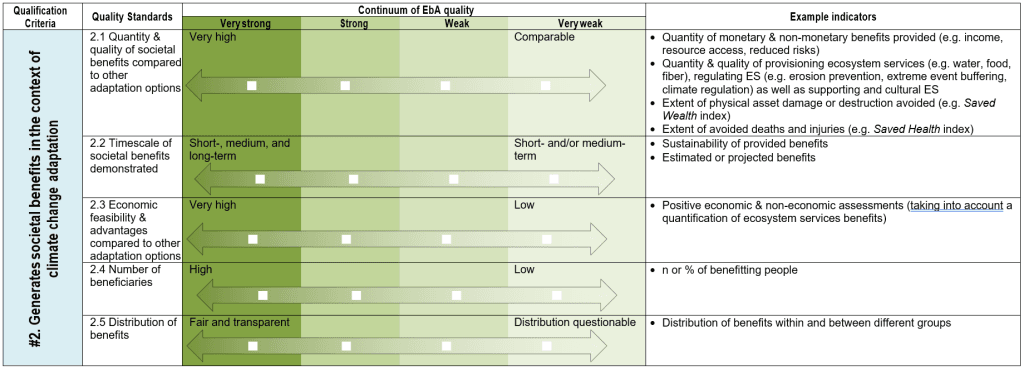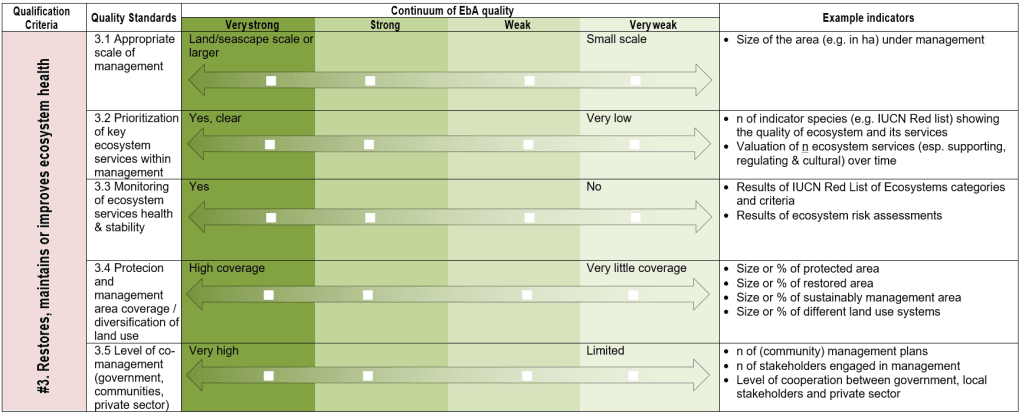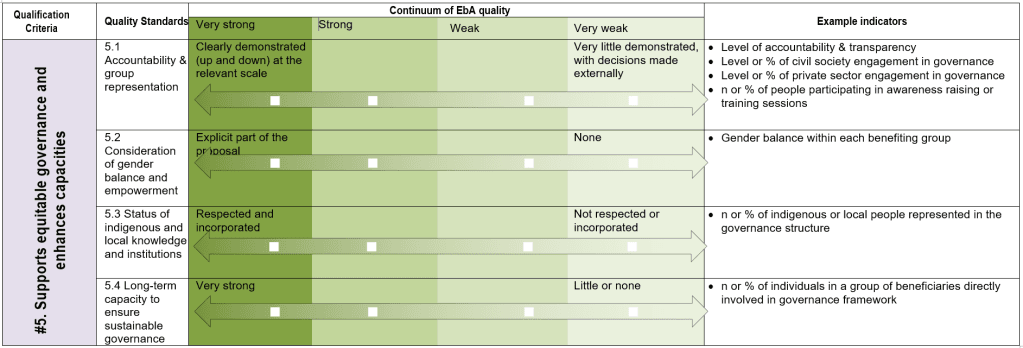EbA Criteria
One of the early priorities of the early FEBA network in 2017 was to create a qualification criteria framework for EbA, with the intent to sharpen understanding among practitioners and policymakers of what qualifies as EbA.
These EbA criteria are structured around the 2009 CBD definition for EbA which says that EbA (i) helps people adapt to climate change (ii) by an active use of biodiversity and ecosystem services, (iii) in the context of an overall adaptation strategy. All three elements of the CBD definition must be addressed in order for an activity, initiative, project, approach, strategy and/or measure to qualify as ecosystem-based adaptation.
Not only do the five criteria help determine whether a proposed activity is actually EbA, but they also help practitioners avoid maladaptation – whereby the activity is in fact detrimental to adaptation in the long-term, in a different aspect (socially, environmentally, economically, etc.), or for a neighboring area.
The following summary is derived from the FEBA technical paper, Making Ecosystem-based Adaptation Effective – A Framework for Defining Qualification Criteria and Quality Standards, available here: EN | ES | FR
Element A – EbA helps people adapt to climate change
Criterion 1. Reduces social and environmental vulnerabilities.
EbA must explicitly address current and future climate change and climate variability. It is based on assessments of climatic vulnerability, hazards and risks to people, as well as the adaptation benefits derived from ecosystem services. A combination of climate information (based on the best available scientific data and models and local knowledge) and vulnerability assessments should form the basis for implementation. EbA measures need to reduce climate vulnerabilty for people at an appropriate scale (e.g. at least local scale but ideally ecosystem or landscape/seascape scale).
Criterion 2. Generates societal benefits in the context of climate change adaptation.
EbA reduces vulnerabilities of people through the use of biodiversity and ecosystem services and by producing societal benefits in a fair and equitable manner. It addresses the needs of people, especially those who directly depend on or use natural resources and who are particularly vulnerable to climate change impacts. EbA delivers direct or indirect benefits that increase peoples’ resilience to climate change, including enhanced food security, shelter, risk reduction, provision of fresh water and medicine, and local climate regulation. It also often generates additional benefits essential for sustainable development including carbon sequestration, habitat provision or medicinal resource provision. In order for EbA to support adaptive capacities it needs to distribute short-, medium- and long-term benefits. Comparative analyses on the extent and scale of adaptive capacity and resilience benefits should clarify whether EbA measures are economically feasible and can complement or substitute other adaptation options. Benefits should be distributed fairly among a representative percentage of the target group.
Element B – EbA makes active use of biodiversity and ecosystem services
Criterion 3. Restores, maintains or improves ecosystem health.
EbA restores, maintains and improves ecosystems, land- and seascapes. It is applied at a scale that addresses the challenge of, and integrates the trade-offs resulting from climate change, meaning it supports the stability, resilience, connectivity, and multiple roles of ecosystems as part of larger land- and seascapes. EbA encompasses measures such as ecosystem management, reinforcement and restoration of natural infrastructure, as well as the management of threats associated with the effects of climate change or anthropogenic activities. Because climate change can force changes in ecosystem composition and structure, it is important that the health and stability of ecosystem services are maintained, improved, and monitored. EbA fosters appropriate land and water management practices that support climate change adaptation, prioritize the management of key ecosystem services, and foster the sustainable use of land and coastal and marine resources (e.g. by conservation and climate-smart agriculture, soil conservation, use of water retention areas, low impact fishing). It supports the diversification of land and marine use and livelihood options such as multi-cropping, agroforestry, and the use of appropriate species and varieties. For example, this can include the introduction of species that are better adapted to climate change, as long as they do not endanger the existence of native species or become invasive. Co-management approaches that involve stakeholders from communities, government and private sector should be supported.
Element C – EbA is part of an overall adaptation strategy
Criterion 4. Is supported by policies at multiple levels.
As part of a larger adaptation strategy, EbA operates at one or more levels (i.e. local, national, regional, landscape, and sectoral levels), and can involve supporting sectoral adaptation and multi-sectoral approaches at multiple geographic scales. It is, or becomes, an integral part of key policies and implementation frameworks targeted towards sustainable development, agriculture, land use, poverty reduction, natural resource management, climate change adaptation, and disaster risk reduction. EbA should be integrated into existing policy frameworks so that interventions can be sustainable and scalable, rather than short-term and stand-alone.
Criterion 5. Supports equitable governance and enhances capacities.
EbA enhances governance of natural resources with respect to the use of biodiversity and ecosystem services, by following a community-centered, participatory and gender-sensitive approach; it embraces transparency, empowerment, accountability, non-discrimination and active, meaningful and free participation at the local level. It should support fair and equitable sharing of user access, rights and responsibilities. The ability to adapt to climate change hinges on the ability of local people (comprising different groups, genders, customary bodies, etc.) to take on their rights and responsibilities and to be represented by officials who are accountable to them. Ownership by the people responsible for ecosystem management and by people who are using and benefiting from biodiversity can ensure that benefits emerge and are sustainable. Strong local governance needs to be embedded in higher level governance structures, which can facilitate and stimulate local action through the right policies and enabling environment.






